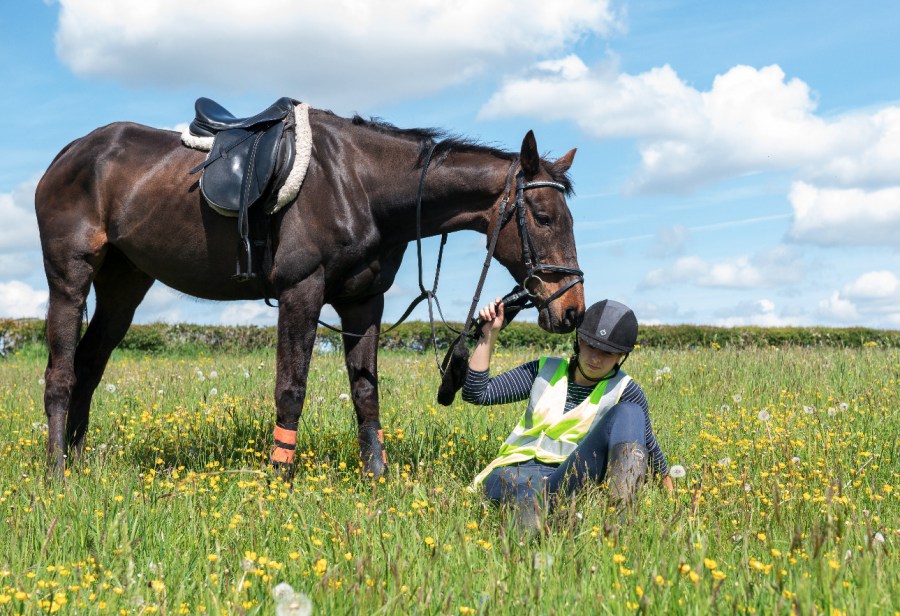Did you know that research has showed that women sustain more frequent and more severe head and brain injuries in sports, including horse riders, than their male counterparts?
Ongoing research is evidencing that women’s cervical spine and neck strength have a considerable impact on the outcome of a brain injury, due to the way that the head moves during an accident, a fall or a collision. This results in the brain moving differently, and consequently impacting the level of damage at a neuronal level.
So if you fall off your horse or are kicked in the head, be aware that due to the difference in neck strength, there could potentially be a head injury risk.
Further research also indicates that hormonal fluctuations and stages of the menstrual cycle can also impact post-injury symptoms, recovery time, and severity. Evidence suggests that where a woman is in her menstrual cycle when she sustains her brain injury can have a significant impact on the outcome.
Recovery from injury is also impacted by hormonal fluctuations, requiring understanding from treating professionals that long-term symptoms can flare or worsen during ovulation, luteal phase, or menstruation, depending on the individual.
This research is relatively new, and most healthcare providers and doctors may not be aware of it, so be sure to mention this when you seek medical advice, especially if your symptoms are lingering or worsening.
Some studies have indicated that women have longer recovery times overall and may have more long-term symptoms than males, so it is really important to raise concerns and be aware of your cycle.
Brain injuries: the research
Accidents when horse riding are common, and while not all of these are serious, in some cases a fall or blow to the head can lead to brain injury or trauma. Currently, it does not take much of a search to find out the high prevalence of brain injury that is sustained through sports.
There have been several class action claims raised across the globe in rugby, football, and boxing hitting the headlines, but it might come as a surprise to hear that horse-related injuries accounted for a huge 22% of all sports-related head injuries studied (1).
The vast majority of head injuries in riders are sustained by a fall from the horse, but they can also occur due to kicks too. Another study that analysed data between 2003 and 2012 concluded that horse riding accidents accounted for the largest number of brain injuries than in any other sport (2).
Over the 20 years I’ve worked with individuals with traumatic brain injuries, horse-related injuries are the most common sporting injury that I have encountered, so learning more about them and how to prepare yourself in case it should happen to you is vital.
What is a brain injury?
Brain injuries vary greatly and there are three types: mild, moderate and severe. All of these could potentially be caused by a horse-related head injury, and the severity is dependent on several factors, such as the length of time the rider is unconscious and the length of time of post-traumatic amnesia.
In the UK, the statistics are that a brain injury is sustained every 90 seconds, but not everyone reports their injuries, which means the numbers are considerably higher than the data suggests.
Mild brain injuries in horse riders
Mild brain injuries (such as concussion) can have either brief or no loss of consciousness, and symptoms can include vomiting, dizziness, memory recall issues, tiredness, and headaches. Symptoms can vary greatly but mild doesn’t always mean there is no long-term impact.
Moderate brain injuries in horse riders
Moderate brain injuries will be marked by a period of unconsciousness for up to 24 hours, and there will likely be signs of trauma such as a skull fracture, bleeding, or contusions. There may be indications from brain scans of damage, although some scans do not pick up all brain injuries.
Severe brain injuries in horse riders
Severe brain injuries are marked by longer periods of unconsciousness, more visible damage and lifelong and life-changing outcomes.
When to seek medical help after a fall
Fallen off your horse? How do you know if you need to dash to A&E? Firstly, understanding the wide range of symptoms that exist with a concussion is important. While most people will know that signs of sleepiness, vomiting, or nausea could be indicators of a potential concussion, there are several other symptoms not so well known.
Other physical symptoms like headaches, dizziness, and sensitivity to light or noise can also serve as red flags. In addition, subtle cues such as ringing in the ears, altered perception of movement, or balance issues may hint at underlying concerns.
Cognitive difficulties such as memory lapses, trouble focusing, and slowed cognitive processing are commonly observed following a concussion. These challenges may appear as struggles with word retrieval, cloudy thinking, or a confusion.
Emotional shifts, including sudden mood swings, irritability, and heightened anxiety, can also be indicative of concussion-related issues that warrant attention.
Symptoms of concussion
Concussions have a profound impact on an individuals well-being and performance across domains, at work, home, and play. The aftermath of a concussion can limit a person’s capacity to carry out certain tasks, resulting in decreased productivity and potential safety risks.
Post-concussion cognitive challenges may hinder decision-making skills, focus, and overall cognitive function, directly influencing performance and efficiency.
Emotional struggles arising from a concussion can trigger heightened stress levels, diminished motivation, and interpersonal relationship difficulties with the impact of this being far-reaching.
Sleep disturbances and disruptions in maintaining a healthy diet and exercise routine are common consequences of both physical and mental symptoms post-concussion.
It’s important to note that these effects are not merely psychological responses to head injury; they are tangible and affect individuals in varying ways. Many will experience issues with mood and acknowledgment of these symptoms if they perceive that ‘only’ a concussion has been sustained.
Generally speaking, these symptoms will diminish after a few days, although sometimes they can linger for up to two weeks. It is not uncommon for symptoms to continue past this point, leading to post-concussion symptoms. However, if there is a worsening of symptoms or no change after 72 hours, this is cause for concern.
Any concussion warrants medical attention, so any fall where the head is affected, or a kick to the head, no matter how minor, should be checked as it’s better to be safe than sorry.
Wearing a riding hat: there is still a risk
You should always wear a helmet when you ride, because they can prevent and reduce the risk of injuries to the skull, such as fractures and open head injuries. However, while an up-to-standard riding hat is vital, it, unfortunately, does not prevent concussions or other brain injury entirely.
Therefore, don’t assume that just because you’ve worn a helmet means you don’t need to get medical attention or you shouldn’t follow other safety steps. Your brain still moves around in the skull with a helmet on, which results in damage to the neurons at a cellular level. Helmets certainly do provide protection, but there is still a risk.
Recovering from a head injury
Recovery from concussion can be challenging, partly because the injury is often not perceived as ‘severe’ enough to warrant the rest and reintegration to activity that is recommended. There is no need to lie in a dark room for 2-3 days. You can still go about some daily activities, although at a low level and only to the point before symptoms worsen.
Reduce your load for at least 3-4 days. Avoid computer work as this can increase symptoms due to the visual processing systems struggling after a concussion.
But what about getting back on the saddle? Exercise and riding must be gradually reintroduced and only after your symptoms have diminished.
Often people will feel relatively okay, perhaps the headaches have reduced, and ‘only’ some fogginess and tiredness remains. However, this is still too soon to return to riding, particularly if the injury occurred within the last two weeks.
Your brain is unique
Unfortunately, there is no manual or set timeframe for return to riding, as each person and brain recovers differently.
A brain is as unique as a fingerprint, and any damage impacts each brain differently, so the remaining symptoms should not be ignored, even if you have received a clear scan. Therefore, getting back to riding before you’re ready can end badly.
While there is no one set timeframe for returning to horse riding after a brain injury, what we do know is that there is a considerable risk to the brain that occurs with a second impact, and post-concussion you’re more susceptible to a greater level or damage with a second concussion.
How to reduce your risk of head injury
There are things you can do to reduce your risks when riding or handling a horse. After all, even walking down the road or driving to the stable carries a level of risk, but we still do this multiple times every day.
There are protective measures to consider when riding to lower your risk of a brain injury:
- Ensure you have a well fitting riding hat that meets industry standards, as well as protective clothing.
- Keep up with training and continue to hone your riding skills to ensure safety and competency. Confidence and capability enable you to handle the horse safely and reduce the risk of falls.
- Know yourself and your horse. Staying in tune with both of you ensures you can preempt any changes in behaviour, that your horse feels safe and you both feel calm and relaxed.
- Be vigilant of your environment to ensure you can anticipate any potential hazards, distractions or obstacles. Stay alert and ensure you are well rested and well before any rides.
- Pay attention to your own body and mind. If you experience any cognitive or physical symptoms, return home or stop the session and monitor how you feel. This is particularly important if you have had a previous fall or are just feeling out of sorts.
- Be sure to rest and recharge between sessions, allowing time for recovery from the longer or more tiring rides or practices. If you feel unwell, skip your ride for the day to recuperate.
What to do after a fall
After a fall or an injury to the head, do not return to riding until you have been advised to — your brain needs to be given time to heal. If you haven’t sought medical attention, do not ride until symptoms have subsided.
Should you experience a return of symptoms, cease activity and seek medical attention. In the event that your symptoms worsen or there is no improvement within 72 hours, ensure you see a medical professional.
If you experience severe symptoms call 999 or attend A&E. A quick response can ensure swift treatment and reduce the risk of long-term symptoms and damage.
By ensuring you keep these tips in mind, you reduce the risk of serious injury and can enjoy riding, reaping the mental benefits longer term, allowing you to continue in your much loved sport with confidence.
Main image: copyright Your Horse Library/Kelsey Media Ltd
Research links
- (1) https://www.stir.ac.uk/news/2024/january-2024-news/study-reveals-longer-term-impact-of-sport-related-brain-injuries/#:~:text=Researchers%20 also%20found%20that%20 certain,%2C%20and%20football%20(13%25).
- (2) Winkler, E. A., Yue, J. K., Burke, J. F., Chan, A. K., Dhall, S. S., Berger, M. S., Manley, G. T., & Tarapore, P. E. (2016). Adult sports-related traumatic brain injury in United States trauma centers. Neurosurgical Focus FOC, 40(4), E4. https://doi.org/10.3171/2016.1.FOCUS15613










